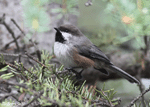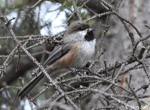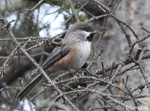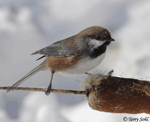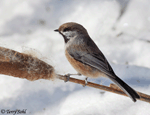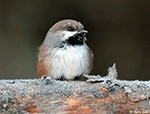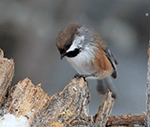| Length: 5.5 inches | Wingspan: 8.25 inches | Seasonality: Rare Visitor |
| ID Keys: Grayish-brown cap, gray nape, brownish flanks, gray wings and tail | ||
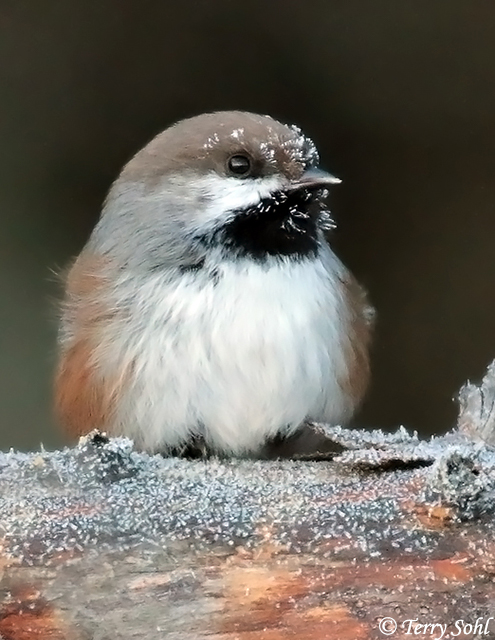 Boreal
Chickadees are mostly birds of Canadian conifer forests, and for the most part
are only rarely found south into the United States. They are only
extremely rare visitors to South Dakota. They are generally quite tame and
sociable birds. They can be identified from other chickadee species by
their unique plumage characteristics, typical range, and by their song.
Boreal
Chickadees are mostly birds of Canadian conifer forests, and for the most part
are only rarely found south into the United States. They are only
extremely rare visitors to South Dakota. They are generally quite tame and
sociable birds. They can be identified from other chickadee species by
their unique plumage characteristics, typical range, and by their song.
Habitat:
Boreal Chickadees are primarily found in conifer forests. They are found as far north as the stunted spruces at the treeline in far northern Canada. In some parts of their range that are dominated by trees like willow, birch, or alder, they may utilize habitats with lesser amounts of conifer.
Diet:
Insects, spiders, and seeds. Feeds heavily on insect eggs and larvae, especially in the winter.
Behavior:
Boreal Chickadees primarily forage by clambering through dense conifer vegetation, gleaning insects from the foliage and branches. They will occasionally hover and glean insects, or feed on the ground as well. They will use their small bill to poke through crevices in and under the bark of conifer trees in search of insects and larvae.
Nesting:
May through June. In their breeding range, the nest is a cavity in a tree, either a natural cavity or an old woodpecker hole. The nesting cavity is lined with strips of bark, moss, lichens, feathers, and plant down. The female lays between 5 and 8 eggs, and she alone incubates them. When the eggs hatch, both parents help to feed the young. The young leave the nest after 16-20 days.
Song:
Boreal Chickadees have a buzzy dee-dee-dee call reminiscent of other Chickadee species. They also a "gargling" call and other short chip notes.
- Click here to hear mixed calls of a Boreal Chickadee1
- Click here to hear a hot mess of a mix of calls from a Boreal Chickadee2
- Click here to hear a more traditional gargle call of a Boreal Chickadee3
Interactive eBird Map:
Click to access an interactive eBird map of Boreal Chickadee sightings
Migration:
Boreal Chickadees are considered permanent residents throughout their range. Short-distance movements may occur in the fall as family groups disperse, and/or birds move short distances to maximize foraging opportunties.
Similar Species:
Boreal Chickadees could be confused with multiple other Chickadee species that are found in their range:
- Black-capped Chickadee - Black-capped Chickadees have a (surprisingly!) black cap, compared to the brownish cap of a Boreal Chickadee. Black-capped Chickadees also have variable amounts of a light buffy color on their flanks, compared to the darker, richer reddish-brown flanks on a Boreal Chickadee. Black-capped Chickadees also have a more extensive white patch on the face than a Boreal Chickadee.
- Mountain Chickadee - Mountain Chickadees have a unique white eye stripe that differentiates them from other Chickadee species. They also have a black cap, a broad white cheek patch, and plain whitish or grayish flanks, compared to the brown cap, smaller white cheek patch, and rusty-colored flanks of a Boreal Chickadee.
- Chestnut-backed Chickadee - Chestnut-backed Chickadees have a Chestnut-colored back and flanks, compared to the gray back and lighter, rusty color on the flanks of a Boreal Chickadee. Chestnut-backed Chickadees also have a black cap compared to the brownish cap on a Boreal Chickadee.
- Gray-headed Chickadee - Gray-headed Chickadees are a mysterious, little understood species with a very small range in northern Alaska and far northwestern Canada. Range alone is a good way to differentiate them from Boreal Chickadees, for birds seen outside of this area. As per the namesake, Gray-headed Chickadees have a brownish-gray cap compared to the brown cap of a Boreal Chickadee. They also have a more extensive white facial patch than that of a boreal Chickadee.
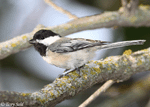 |
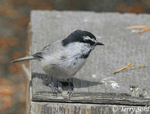 |
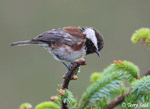 |
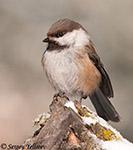 |
| Black-capped Chickadee | Mountain Chickadee | Chestnut-backed Chickadee | Gray-headed Chickadee |
Conservation Status:
Systematic surveys over the last several decades have shown substantial declines in Boreal Chickadee populations. However, they are still found over a very broad geographic area, are common in parts of their range, and overall populations are currently not deemed to be at any substantial risk. The IUCN considers the Boreal Chickadee to be a species of "Least Concern".
Feeders:
Boreal Chickadees will attend feeder setups for suet, peanut butter, and sunflower seeds.
Further Information:
Photo Information:
December 30th, 2014 - Sax-Zim Bog, Minnesota - Terry Sohl
Additional Photos:
Click on the image chips or text links below for additional, higher-resolution Boreal Chickadee photos.
Audio File Credits:
- 1Martin St-Michel. Recorded in Charlevoix, Quebec on August 4th, 2014. Original recording and more information availble from xeno-canto.
- 2Andrew Spencer. Recorded in Coos County, New Hampshire on June 24th, 2008. Original recording and more information availble from xeno-canto.
- 3Andrew Spencer. Recorded in Washington County, Maine on April 5th, 2010. Original recording and more information availble from xeno-canto.
| Click on the map below for a higher-resolution view |
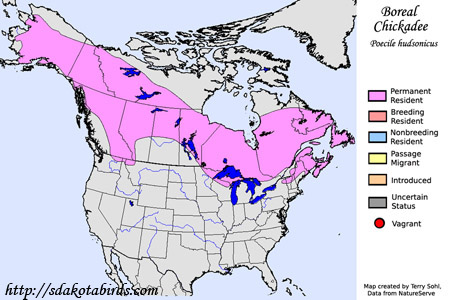 |
| South Dakota Status: Extremely rare visitor, with only a handful of records in the state. |
Click for a higher-resolution version of these photos
